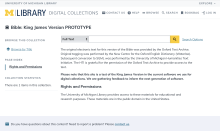Showcasing the technology, services, and contents of our digital collections platform.
The Digital Collections Files

Posts in The Digital Collections Files
Showing 1 - 10 of 31 items

- Olivier U Bahizi
Olivier Bahizi, recipient of our summer 2025 Fellowship in Library User Experience, shares insights from his study of challenges users face when navigating the U-M Library's archival and digital collections across several platforms. Key themes include difficulties in discovery and access, limitations due to metadata, and lack of awareness and information literacy about archival materials.

- Latitude Brown
- Andrew John Katsumi Nakamura
- Kat Hagedorn
From January-September 2025, we were excited to have the assistance of two interns. Latitude Brown and Andy Nakamura helped us improve descriptive metadata and content in several of our digital collections, particularly those that address potentially objectionable or harmful material. This blog post shares their experiences and highlights the projects they worked on.

- Robyn Ness
The University of Michigan Library’s Bible: King James Version (KJV) digital collection is one of our oldest and most-visited text collections. At nearly 30 years old, the collection’s design reflects the early days of the Web. With effort underway to update the functional underpinnings of our digital collections, it was time to return to the KJV to study how well the text would work within our updated site layout, which is now used across the majority of our text collections.

- Justin Schell
- Kat Hagedorn
We often look for mechanisms to create better and more robust metadata about our materials in our digital collections. The Digital Collections Service partnered with Shapiro Design Lab at U-M Library to use Zooniverse, a crowdsourcing platform that allows us to post existing materials for anyone to view and add descriptive information to. We improved two digital collections using improved metadata from Zooniverse crowdsourcing.

- Ruikun Wang
- Ben Howell
Part 2 of the series "Uncovering Needs of Filipino Researchers with our Philippines Digital Collection" explores a UX research study aimed at improving the University of Michigan’s Philippines digital collection interface. The study initially focused on understanding user pain points with the legacy collection interface. Following the launch of a redesigned interface, short-term fixes were implemented based on user feedback, while long-term needs were documented for future platform updates.

- Ben Howell
In June 2003, the University of Michigan Library launched the Philippines digital collection, “The United States and its Territories, 1870 - 1925: The Age of Imperialism.” Featuring over 4,000 historical texts, it has seen significant engagement from Filipino users for twenty years. Contextual inquiry interviews with Filipino researchers revealed their appreciation for the preservation and access to historical materials, their enthusiasm for being included in research and design activities and opportunities to improve usability in specific areas. Our findings show the importance of enhancing digital collections to support researchers and preserve cultural heritage, especially for communities who have experienced the loss of these materials in their country of origin.

- Emma Brown
- Suviksha Hirawat
As user experience researchers and designers, it is our job to design better solutions for complex interfaces. Read on to learn our research and design process from discovering a usability issue to proposing solutions in collaboration with developers.

- Kat Hagedorn
- Robyn Ness
In our inaugural Digital Collections Connection meeting on March 7, 2024, we shared a couple of slides that showcase the history of the technical infrastructure for digital collections at U-M Library. During the session, we heard that this overview of our systems was helpful to content partners in understanding current functionality and limitations. We wanted to take this opportunity to share the diagrams more widely and to provide more context and historical information about the origins of, and recent changes to, our digital collections platform.

- Emma Brown
- Robyn Ness
The U-M Library’s digital collections recently expanded to include an Audio and Moving Image (or AMI) digital collections interface. This post details a designer's journey in finding a banner image for the Hazen Schumacher's Jazz Revisited Radio Show digital collection.

- Kat Hagedorn
- Robyn Ness
- Chris Powell
- John Weise
After the successful launch of our ArcLight finding aids application on April 19, 2023 - and the deprecating of our homegrown Digital Library eXtension Service (DLXS) finding aids application - we are sharing our reflections on the project with the wider community. This blog post will describe the history of finding aids at the University of Michigan Library and what led us to develop the ArcLight finding aids application, starting in earnest in 2020. We will describe our goals for the project, the organization of the development team, and the modifications that we needed to make to effectively complete the project. We will give an overview of what a finding aids application does, and why we decided to use ArcLight as well as Docker and Kubernetes as our new containerization and hosting solution. We will discuss what was advantageous to us for this project as well as what was particularly challenging, and sum up what we learned from our archives partners and end-users, throughout the project.